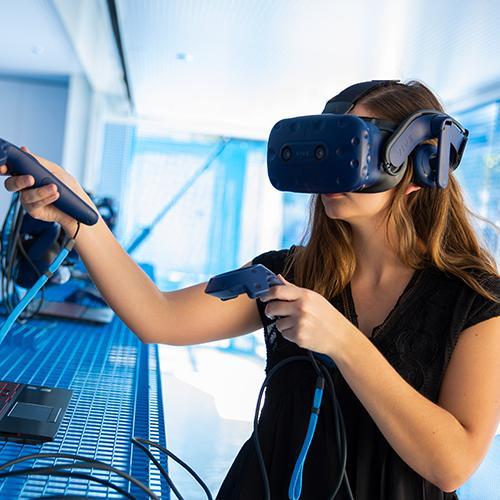Intel’s Tech Learning Lab Offers a Virtual Education, on Wheels
Intel and HP partner on a mobile learning lab, bringing VR and high-tech experiences to students

On a recent morning at McClymonds High School in west Oakland, California, students soared through outer space, dissected frogs in a high-tech laboratory and toured the a Smithsonian American Art Museum exhibition up close — all without leaving their campus.
These students are part of the Tech Learning Lab, a partnership between Intel, HP and other tech companies. The custom-built mobile classroom is loaded with tech goodies, bringing access to advanced technology to students and teachers across the country.
“HP has always been focused on inventing and reinventing technology,” says Joanna Popper, HP’s global head of virtual reality for location-based entertainment. “We’re excited to put new technology in the hands of students around the country to expose them to what’s next.”
STEM education is increasingly becoming a priority in the U.S., where jobs in tech and STEM fields are booming, but science, technology, engineering and math education has some catching up to do. Since 1990, STEM employment in the United States has grown by 79 percent, according to a 2018 Pew Research Center survey, and will grow another 13 percent by 2027. But according to Code.org data, only 35 percent of U.S. high schools teach computer science. America lags behind other nations when it comes to STEM graduates; the U.S. is ranked 27th (out of 29) for the rate of STEM bachelor’s degrees awarded in developed countries.
To increase those numbers, introducing powerful technology to students that can perform skilled tasks like coding or robotics is more important than ever — not only for their own job prospects, but also for the health of the U.S. labor market in the 21st century. And, it’s just plain fun.
At one of the Tech Learning Lab stations at McClymonds, students laughed as they painted virtual stars and fireballs into the air in front of them. One girl giggled about feeling self-conscious waving her arms around while strapped into a sensory headset. (“Don’t worry, no one’s looking at you!” an attendant encouraged her.) Nearby, students teleported into a virtual game show where they learned real-life chemistry lab skills.
“They’re totally immersed,” said Alyson Griffin, head of brand at Intel, who was on site watching students try out different learning stations. “They’re not thinking about anything other than the experience.”
A new educational path
The Tech Learning Lab started its journey at the Bronx Academy of Letters in New York City, and then trucked its way to schools and other educational institutions in Massachusetts, Georgia and California during the latter part of 2018.
The lab can virtually transport students to the Renwick Gallery at the Smithsonian American Art Museum in Washington, D.C., where they can virtually take in an exhibit called “No Spectators: The Art of Burning Man.” There’s a game where they can create and test virtual robots, and a room-scale 3D painting VR experience from Google called TiltBrush. On the STEM side, the life science dissection lab by VictoryVR provides a vivid frog dissection simulation led by a hologram of a national award-winning science teacher. (The best part: It’s all formaldehyde-free!)
In addition to going on excursions via VR, students could check out powerful PCs, including OMEN by HP gaming laptops, desktops, accessories, HP Chromebooks and smart whiteboards. They also learned in immersive, hands-on workshops, including one where they had the chance to code their own drone flight path.
“We hope we can expose students to new ways of thinking through powerful technology,” says Raysana Hurtado, education segment manager at Intel. Hurtado says these early experiences with tech can spark an interest and help build skills that can lead to “creating pipelines of talent for companies and diverse opportunities for students in jobs that weren’t around 10 years ago.”
Kennan Scott, the manager of computer science for the Oakland Unified School District, says he hopes these visceral encounters with technology encourage students at McClymonds and elsewhere to not only pursue careers in tech, but dive into their own potential as creative thinkers.
“We have a model of education that's been around for 60 years, and is pretty stagnant, to say the least,” he says. “It hasn't evolved as rapidly as everything else around it has evolved. So, when I see students, what I want them to do is really go into the tech space and find their own creativity in the tools right away."
Learning that lasts
Even though the Tech Learning Lab is on wheels, the learning experience doesn’t roll away with it. The truck leaves behind a curriculum kit of activities and lesson plans from its workshops that teachers can use in future classes.
“We knew the learning lab alone wouldn't be enough,” Hurtado says. “We needed to teach the teacher and hear from them. At every stop, we're hearing feedback, and we're iterating on how the courses should be taught and what they need more of. Then we're trying to go back to the drawing board and fix and tweak things.”
And though the truck only stayed for a day, Scott hopes its impact will extend much longer, inspiring students to learn more about what technology like artificial intelligence, VR and the Internet of Things can do for the world and for them personally.
“The more that they see themselves as part of this wave, I think the more we'll see students self-identify with this space and be more aware of the impact tech has on everything,” Scott says.

